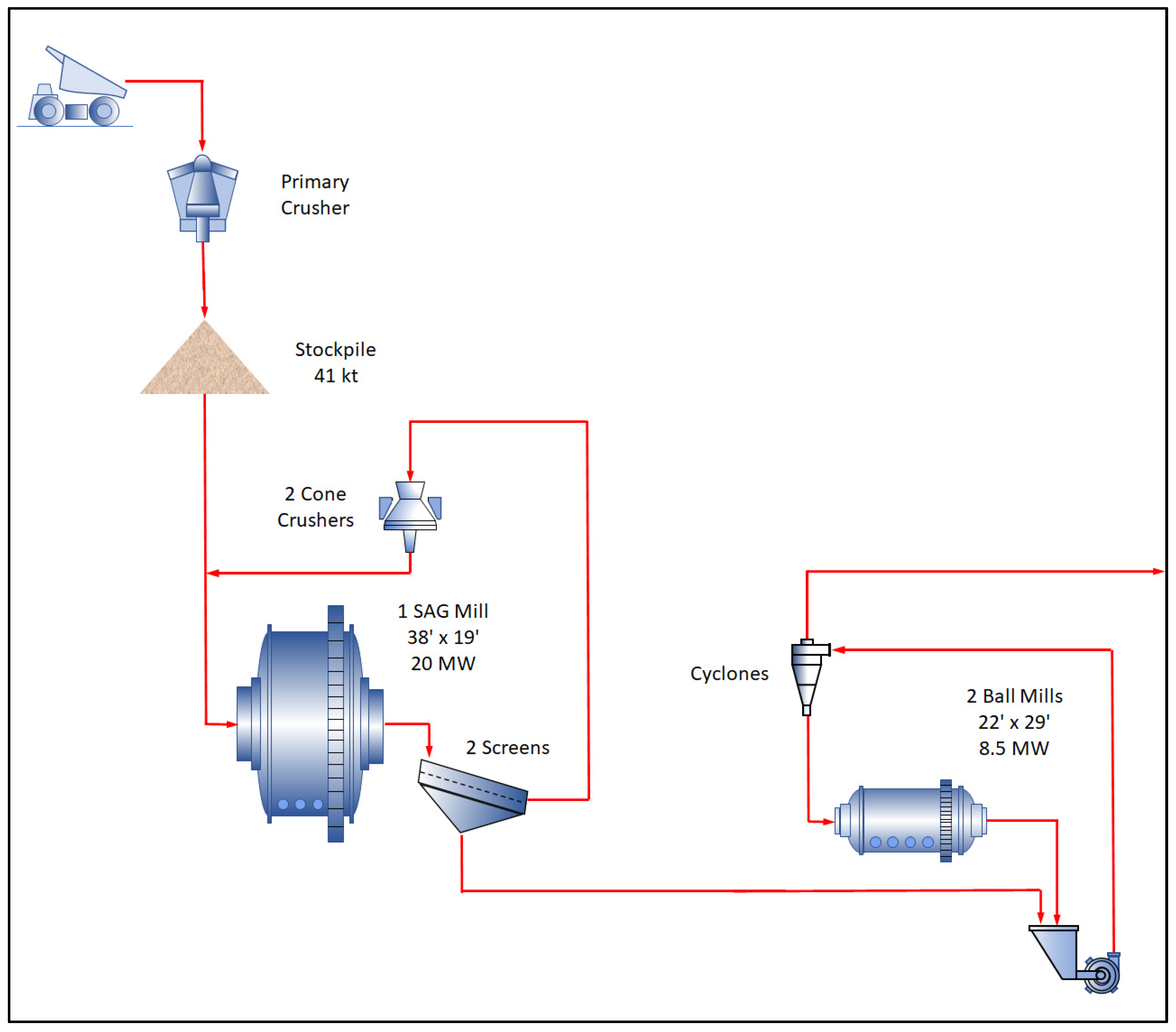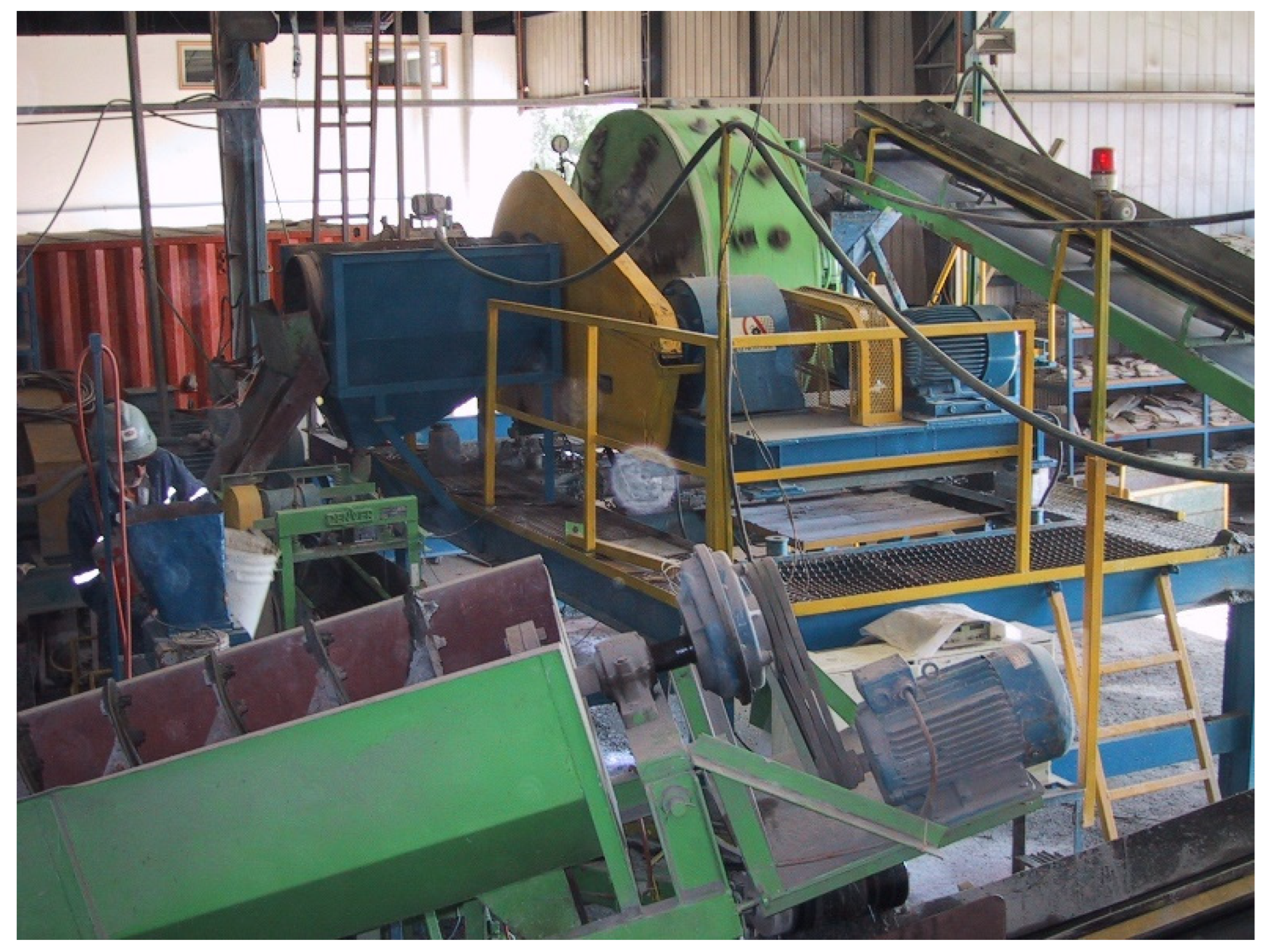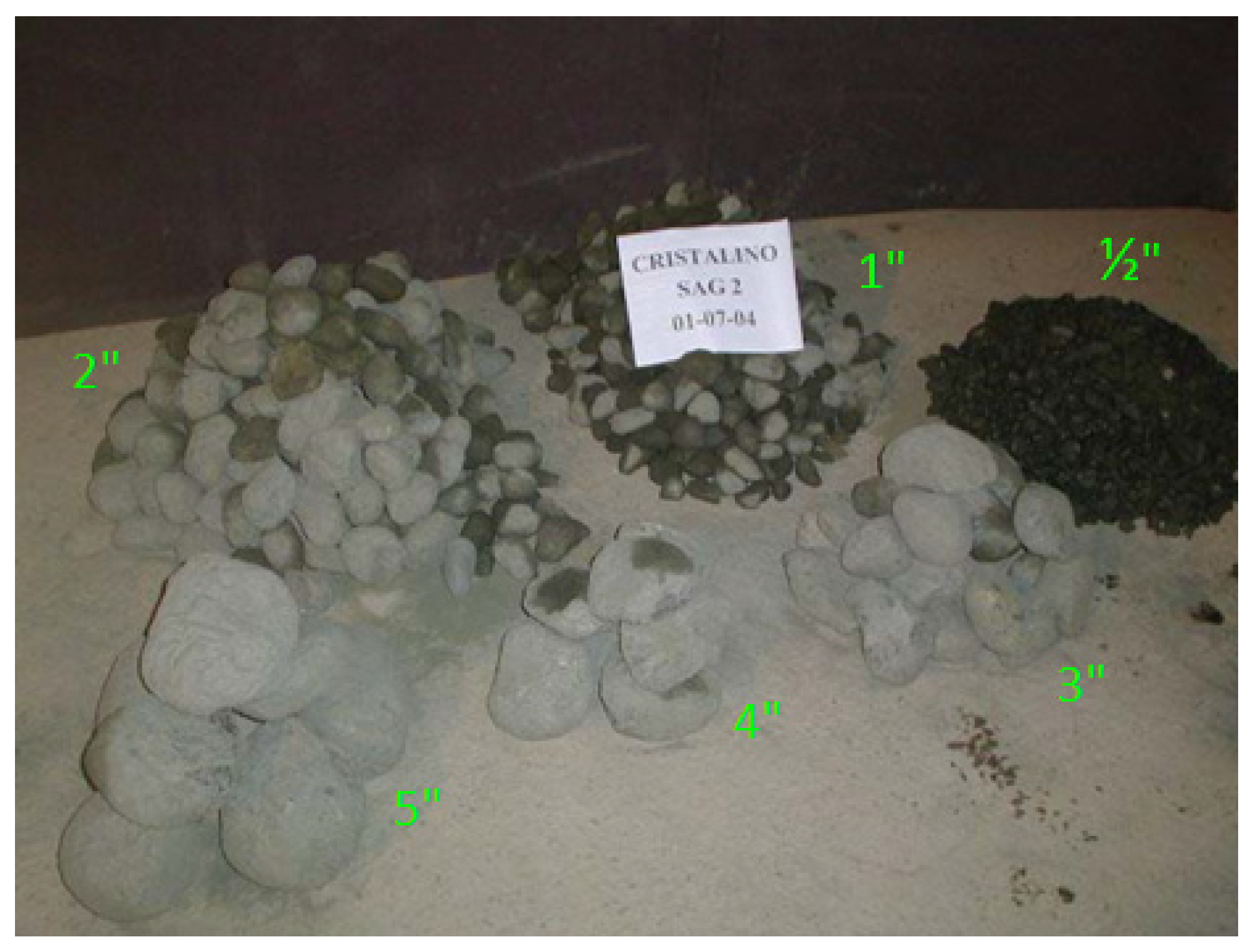Pre-Processing to Increase the Capacity of SAG Mill Circuits—Case Study
Abstract
:1. Introduction
1.1. Objective
1.2. Literature Review
1.3. Sossego Grinding Circuit
2. Experimental
2.1. Ore Characterization-Bench Scale Test Work
2.2. Pilot Plant Campaign
3. Results and Discussion
3.1. Ore Characterization
3.2. Pilot Plant Campaign
4. Simulations
4.1. Crushing Circuit
4.2. Grinding Circuit
5. Conclusions
- Breakage Index results averaged 31.1 for the 98 tested samples, thus indicating a high tenacity for single-particle fragmentation. The calculated coefficient of variation indicated a relatively low value (16%), showing a highly homogeneous distribution regarding the single-particle fragmentation for tested Cristalino samples;
- The Bond Wi averaged 17.4 kWh/t for the same 98 Cristalino samples, thus indicating a relatively high resistance to grinding in ball mills, which is an indicator of potential high energy consumption in the secondary grinding stage of a typical SABC circuit configuration;
- Pilot plant testing on Cristalino ore resulted in 7.8 kWh/t specific energy consumption for the reference SAC configuration (SAG-2). Further tests indicated that: (a) a reduction to 7.4 kWh/t by increasing the mill speed (SAG-6), (b) an increased to 9.2 kWh/t by reducing the number of pebble ports open (SAG-12), (c) an increase to 8.1 kWh/t by coarsening the feed size distribution together with increasing the mill speed (SAG-9), as well as (d) a reduction to 6.6 kWh/t by further crushing the feed size distribution (SAG-8);
- The 15% specific energy reduction obtained by including additional crushing in the SAG mill feed (SAG 8 test), as compared with refrence test (SAG-2) was the basis for simulating the processing of Cristalino ore at the Sossego industrial grinding circuit;
- Simulations of a hybrid crushing circuit for Cristalino ore indicated significant different size distributions of primary crushing product (coarse) and secondary/tertiary crushing products (fine);
- Simulations of Sossego grinding circuit processing Cristalino ore indicated that increasingly finer fresh feed size distribution significantly reduced the SAG mill load, therefore increasing the SAG mill throughput. However, the secondary grinding stage throughput limited such higher throughput scenarios essentially due to limitations in the ball mill installed power;
- Simulations of Sossego grinding circuit showed that a blended feed comprising of 35% fines and 65% coarse resulted in 12% increase in the overall grinding circuit throughput, as compared with coarse feed only scenario;
- The calculated energy consumption for entire grinding circuit (SAG and ball milling) was reduced by11% for the selected blend, as as compared with coarse feed only scenario;
- Simulations indicated potential increase in throughput by installing additiaonal ball milling in the industrial circuit.
Author Contributions
Funding
Data Availability Statement
Acknowledgments
Conflicts of Interest
References
- Jones, S.M.; Fresko, M. Autogenous and semi-autogenous mills 2010 update. In Proceedings of the SAG Conference, Vancouver, BC, Canada, 23–27 May 2010. [Google Scholar]
- Gupta, A.; Yan, D. Autogenous and semi-autogenous mills. In Mineral Processing Design and Operations, 2nd ed.; Elsevier: Amsterdam, The Netherlands, 2016; pp. 263–285. [Google Scholar] [CrossRef]
- Siddal, B.; Putland, B. Process design and implementation techniques for secondary crushing to increase milling capacity. In Proceedings of the SME Annual Meeting, Denver, CO, USA, 25–28 February 2007. [Google Scholar]
- Napier-Munn, T.J.; Morrel, S.; Morrison, R.D.; Kojovic, T. Mineral Comminution Circuits: Their Operation and Optimization; Julius Kruttschnitt Mineral Research Centre: Brisbane, Australia, 1996. [Google Scholar]
- Nelson, M.; Valery, W.; Morrell, S. Performance Characteristics and Optimisation of the Fimiston (KCGM) SAG Mill Circuit. In Proceedings of the SAG Conference. Vancouver, BC, Canada, 6–9 October 1996. [Google Scholar]
- Chandramohan, R.; Braun, R.; Lane, G.; Hollis, K.; Le, J.; Baas, D. SAG mill optimisation and increasing throughput at the Phu Kham copper-gold operation. In Proceedings of the AusIMM Mill Operators’ Conference, Brisbane, Australia, 29–31 August 2018. [Google Scholar]
- Morrell, S.; Valery, W. Influence of Feed Size on AG/SAG Mill Performance. In Proceedings of the SAG Conference, Vancouver, BC, Canada, 30 September–3 October 2001. [Google Scholar]
- Delboni, H., Jr. Preliminary Design of Sossego Comminution Circuit; HDA Serviços S/S Ltda.: São Paulo, Brazil, 1999. (In Portuguese) [Google Scholar]
- Bergerman, M.G.; Delboni, H., Jr.; Rosa, M.A.N. Study of variability and Sossego sag mill circuit optimization. REM Rev. Esc. Minas 2009, 62, 93–97. (In Portuguese) [Google Scholar] [CrossRef]
- Mendonça, A.M.; Luiz, D.; Souza, M.; Oliveira, G.; Delboni, H., Jr.; Bergerman, M.G. Sossego SAG mill: 10 years of operation and optimizations. In Proceedings of the SAG Conference, Vancouver, BC, Canada, 27 February 2015. [Google Scholar]
- Rodrigues, A.F.V.; Delboni Junior, H.; Powell, M.S.; Tavares, L.M. Comparing strategies for grinding itabirite iron ores in autogenous and semi-autogenous pilot-scale mills. Miner. Eng. 2021, 163, 106780. [Google Scholar] [CrossRef]
- Chieregati, A.C.; Delboni Junior, H. New methodology for Characterisation of ores applied do ag/sag mills. In Proceedings of the Encontro Nacional de Tratamento de Minérios e Metalurgia Extrativa, Rio de Janeiro, Brazil, 28 June 2001; Volume 3, pp. 49–54. (In Portuguese). [Google Scholar]
- Paredes, B.J.; Reyes, P.J.; Leon, B.P.; Chacana, A.R. Pilot Plant Program of Semi-Autogenous and Ball Mill Grinding and Flotation for Cristalino Project of CVRD, Brazil; Project 31/313-1 Final Report; Centro de Investigaciones Mineras y Metalurgicas—CIMM: Santiago, Chile, 2004. (In Spanish) [Google Scholar]
- Delboni, H., Jr. Design of Cristalino Grinding Circuit; HDA Serviços S/S Ltda.: São Paulo, Brazil, 2004. (In Portuguese) [Google Scholar]





| Index | Wi (kWh/t) | Breakage Index | S.G. |
|---|---|---|---|
| Mean | 17.4 | 31.1 | 3.13 |
| Standard Deviation-SD | 1.5 | 5.1 | 0.22 |
| Coefficient of Variation (%) | 9 | 16 | 7 |
| Mean + One SD | 18.9 | 36.2 | 3.35 |
| Mean − One SD | 15.9 | 26.0 | 2.91 |
| Maximum | 19.8 | 51.1 | 3.85 |
| Minimum | 13.4 | 22.3 | 2.77 |
| Lower Quartile | 16.1 | 27.9 | 2.99 |
| Median | 17.6 | 30.2 | 3.11 |
| Upper Quartile | 19.8 | 51.1 | 3.85 |
| Test | Circuit Configuration | Feed Size Distribution | Mill Speed (% of Critical) | Ball Charge (%) | Pebble Ports Open | Fresh Feed Flow Rate (kg/h) | Mill Power Draw-Net (kW) | Specific Energy (kWh/t) | Circuit Product P80 (mm) |
|---|---|---|---|---|---|---|---|---|---|
| SAG-1 | SAC (*) | Sossego | 72 | 10 | 4 | 1242 | 10.7 | 8.6 | 5.6 |
| SAG-2 | SAC | Cristalino | 72 | 10 | 4 | 1366 | 10.7 | 7.8 | 6.6 |
| SAG-3 | SAC-A (**) | Cristalino | 72 | 10 | 4 | 1504 | 10.9 | 7.2 | 3.4 |
| SAG-4 | FAC (***) | Cristalino | 72 | 0 | 4 | 667 | 7.5 | 11.3 | 5.0 |
| SAG-5 | SAC-A | Cristalino | 72 | 12 | 4 | 1561 | 11.5 | 7.4 | 4.2 |
| SAG-6 | SAC | Cristalino | 75 | 10 | 4 | 1443 | 10.6 | 7.4 | 7.0 |
| SAG-7 | SAC-A | Cristalino | 75 | 10 | 4 | 1521 | 11.1 | 7.3 | 4.7 |
| SAG-8 | SAC | Secondary Crushing | 72 | 10 | 4 | 1664 | 11.0 | 6.6 | 7.0 |
| SAG-9 | SAC | Coarse | 75 | 10 | 4 | 1350 | 10.9 | 8.1 | 6.7 |
| SAG-10 | SAC | Cristalino | 72 | 10 | 4 | 1343 | 10.9 | 8.1 | 6.0 |
| SAG-11 | SAC | Cristalino | 75 | 12 | 4 | 1403 | 11.4 | 8.1 | 7.1 |
| SAG-12 | SAC | Cristalino | 75 | 12 | 2 | 1270 | 11.7 | 9.2 | 6.2 |
| Size (mm) | Accumulated Percent Passing | ||||
|---|---|---|---|---|---|
| Primary Crushing Product (Coarse) | Tertiary Crushing Product (Fine) | Blended Crushing Circuit Product * | |||
| 40% Fines | 35% Fines | 25% Fines | |||
| 300 | 100 | 100 | 100 | 100 | 100 |
| 203 | 94.5 | 100 | 96.7 | 96.4 | 95.9 |
| 127 | 84.1 | 100 | 90.5 | 89.7 | 88.1 |
| 102 | 77.8 | 100 | 86.7 | 85.6 | 83.4 |
| 76.2 | 67.0 | 100 | 80.2 | 78.6 | 75.3 |
| 50.8 | 48.8 | 100 | 69.3 | 66.7 | 61.6 |
| 25.4 | 30.8 | 99.8 | 58.4 | 55.0 | 48.1 |
| 19.1 | 18.4 | 95.4 | 49.2 | 45.3 | 37.6 |
| 12.7 | 12.0 | 69.7 | 35.1 | 32.2 | 26.4 |
| 6.35 | 8.2 | 39.4 | 20.7 | 19.1 | 16.0 |
| 3.36 | 5.8 | 22.6 | 12.5 | 11.7 | 10.0 |
| 1.00 | 3.3 | 8.9 | 5.5 | 5.2 | 4.7 |
| P80 (mm) | 110 | 14 | 76 | 81 | 90 |
| Variable | Base Case | Simulation | |
|---|---|---|---|
| Grinding Circuit Fresh Feed | Primary Crusher Product | Blended-Coarse (65%) and Fines (35%) | |
| Circuit Throughput-Solids | t/h | 1570 | 1758 |
| Increase (%) | - | 12 | |
| Circulating Load-SAG Milling | t/h | 295 | 259 |
| % | 19 | 15 | |
| Circulating Load-Ball Milling | t/h | 5126 | 6520 |
| % | 326 | 371 | |
| Slurry Pulp Pump Flow Rate | m3/h | 6026 | 7449 |
| Increase (%) | - | 24 | |
| Cyclones in Operation | - | 7 | 9 |
| Cyclone Underflow Dilution | % | 80.7 | 80.7 |
| Total Charge Volume-SAG mill | % | 30.0 | 27.3 |
| Power Draw-SAG Mill | kW | 14,696 | 14,542 |
| Power Draw-Ball Mills (each) | kW | 8211 | 8211 |
| Specific Energy-SAG | kWh/t | 9.4 | 8.3 |
| Specific Energy-Ball Mills | kWh/t | 10.5 | 9.3 |
| Specific Energy-SAG and Ball Mills | kWh/t | 19.8 | 17.6 |
| Reduction (%) | - | 11 | |
| Grinding Circuit P80 | mm | 0.210 | 0.210 |
Publisher’s Note: MDPI stays neutral with regard to jurisdictional claims in published maps and institutional affiliations. |
© 2022 by the authors. Licensee MDPI, Basel, Switzerland. This article is an open access article distributed under the terms and conditions of the Creative Commons Attribution (CC BY) license (https://creativecommons.org/licenses/by/4.0/).
Share and Cite
Delboni, H., Jr.; Costa e Silva, E.; Alves, V.K.; Chieregati, A.C. Pre-Processing to Increase the Capacity of SAG Mill Circuits—Case Study. Minerals 2022, 12, 727. https://doi.org/10.3390/min12060727
Delboni H Jr., Costa e Silva E, Alves VK, Chieregati AC. Pre-Processing to Increase the Capacity of SAG Mill Circuits—Case Study. Minerals. 2022; 12(6):727. https://doi.org/10.3390/min12060727
Chicago/Turabian StyleDelboni, Homero, Jr., Evandro Costa e Silva, Vladmir Kronemberger Alves, and Ana Carolina Chieregati. 2022. "Pre-Processing to Increase the Capacity of SAG Mill Circuits—Case Study" Minerals 12, no. 6: 727. https://doi.org/10.3390/min12060727
APA StyleDelboni, H., Jr., Costa e Silva, E., Alves, V. K., & Chieregati, A. C. (2022). Pre-Processing to Increase the Capacity of SAG Mill Circuits—Case Study. Minerals, 12(6), 727. https://doi.org/10.3390/min12060727






